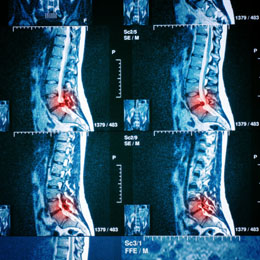If you are looking for information about rheumatoid arthritis that affects the spine, this article will surely be helpful. Here, the symptoms, causes, and possible treatment methods of this disease are presented.

Rheumatoid arthritis is classified as an autoimmune disease, which causes a chronic inflammation of the connecting joints, all over the body. The immune system is a sort of security system of the body, which attacks the pathogenic bodies entering it. Autoimmune diseases like these are a result of this security system backfiring. That is, the immune system mistakenly attacks the body's own tissues, causing autoimmune diseases. The exact mechanism that causes this disease is not known yet, but the autoimmune system definitely plays a role.
In case of this disease, the immune system attacks multiple tissues all over the body, causing inflammation. Hence, the disease is also called a 'Systemic Inflammatory Disorder'. The tissues that are most affected by this disease are the synovial membranes, that form the lining of synovial joints.
These membranes get inflamed, resulting in synovitis, causing pain, along with swelling. If left unchecked, the disease progresses and causes a destruction of bones, cartilages, and ligaments, leading to disability. Almost 1% of the world population and about 1.3 million Americans are affected by this disease. The onset occurs mostly between the age of forty and sixty. Women are three times more likely to be affected by this disease. It often runs in families and may point towards a genetic predisposition.
Symptoms
Rheumatoid arthritis can also affect the joints of the spinal cord. The effects may vary from patient to patient. Here are some of the symptoms connected with it:
- Pain at base of skull, the neck and back, when spinal arthritis affects the cervical spine and progresses downwards.
- Blackout spells due to pressurization on vertebral arteries.
- Irregular gait and problem with keeping balance.
- Tingling, weakness, and coordination loss in arms and legs.
- Incontinence and inability to urinate are some of the symptoms of arthritis in the spine.
Causes
Studies indicate that any patient who has been affected by rheumatoid arthritis for ten or more years, has a more than 50% chance of the disease affecting the cervical spine, leading to an instability between the connection of skull base and upper vertebral column. There are three major causes and complications associated with this disease:
- Alantoaxial Instability: This is a condition of abnormal motion caused between the first and second vertebrae due to joint inflammation, leading to cervical spine instability.
- Super migration of Odontoid: This is caused by erosion of the joint that exists between the base of the skull and the first two vertebrae. This causes a pressing of the odontoid tip against the skull base, eventually leading to increased pressure on the brain stem. It causes coordination problems in the body.
- Sub-axial Subluxations: This is caused when arthritis reaches the lower part of the cervical spine and the vertebrae begin to slip, causing the neck to develop a 'hunched over' kind of posture.
Treatment Options
If you have coordination problems, along with arthritis affecting the joints of the hands and legs, you must get your spine checked for signs of rheumatoid arthritis. Diagnosis is made by the observation of an x-ray or CT scan by a doctor.
Treatment in the initial stages is possible through anti-inflammatory medications that decrease pain and slow down the process of joint destruction caused by the disease. The other option is spinal surgery, which comes with quite an amount of risk and high cost.
Diseased joints are resected and affected vertebrae are fused through surgery. Through spinal surgery, nerves crunched under pressure can be made to decompress, restoring some of the nerve functions. All this can be done, provided the damage is within limits and the disease is in the initial stages.
However, in advanced stages, where joint damage in the spine has already occurred and bones have been affected by an osteoporosis condition, there is little hope for recovery. Hope lies in early diagnosis and dosage of anti-inflammatory medicines.
Do not ignore the signs of arthritis setting in, as the only way to stop it in its tracks, is early diagnosis and treatment.
Disclaimer:This article is for reference purposes only and is not meant to be a substitute for advice from a certified medical practitioner.


 Rheumatoid arthritis is classified as an autoimmune disease, which causes a chronic inflammation of the connecting joints, all over the body. The immune system is a sort of security system of the body, which attacks the pathogenic bodies entering it. Autoimmune diseases like these are a result of this security system backfiring. That is, the immune system mistakenly attacks the body's own tissues, causing autoimmune diseases. The exact mechanism that causes this disease is not known yet, but the autoimmune system definitely plays a role.
Rheumatoid arthritis is classified as an autoimmune disease, which causes a chronic inflammation of the connecting joints, all over the body. The immune system is a sort of security system of the body, which attacks the pathogenic bodies entering it. Autoimmune diseases like these are a result of this security system backfiring. That is, the immune system mistakenly attacks the body's own tissues, causing autoimmune diseases. The exact mechanism that causes this disease is not known yet, but the autoimmune system definitely plays a role.